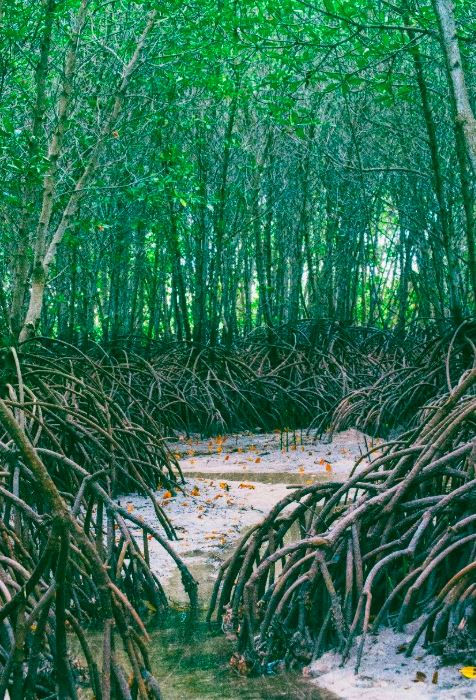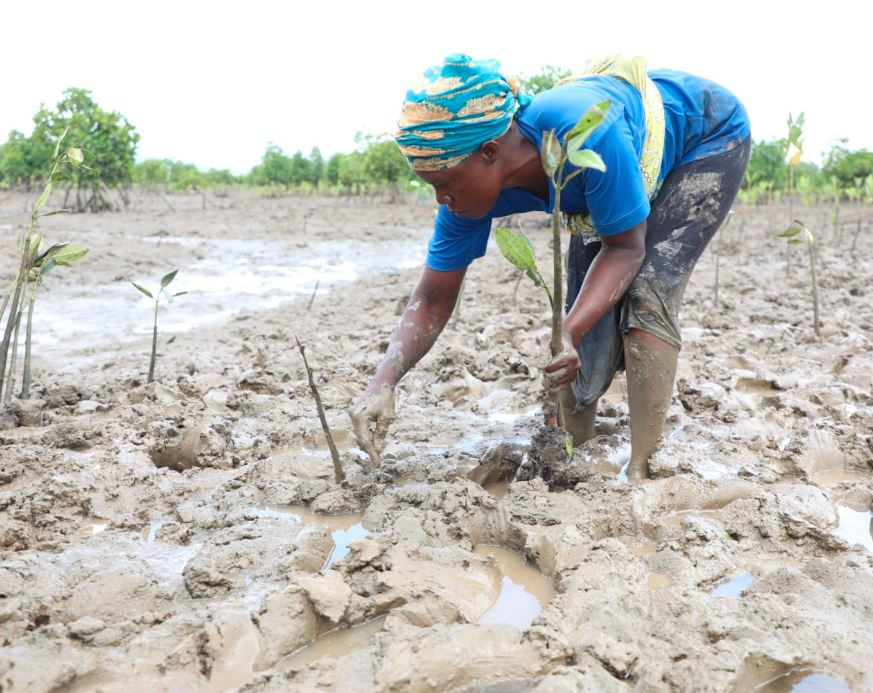Type of Mangrove Trees In Kenya
- BeyondForest

- Jun 23
- 5 min read
Updated: Nov 6
2.)Importance of Mangrove Trees
5.)Mangrove Conservation Efforts
6.)How Pollution Harms Mangroves and Threatens Coastal Ecosystems
7.)FAQ About Mangrove
Mangrove in Kenya cover 61,271 ha making about 3.5% of the gazetted forest cover in Lamu, Tana River, Kilifi, Mombasa and Kwale Counties. - Kenya Wildlife Service
Man in blue shirt on a boat arranging Mangrove plants by Captain Green Ke
Mangroves, locally known as Mkoko, are unique trees and shrubs thriving in the coastal intertidal zones of Kenya. The country hosts three key species – Rhizophora mucronata, Avicennia marina, and Heritiera littoralis – with the first two spread across the entire Kenyan coastline, while Heritiera littoralis is restricted to the Tana River estuary near Kipini.
50 million mangroves have been planted across the 5 coastal counties since 2019.- KWS
Mangroves are natural climate champions, capturing and storing more carbon per hectare than most terrestrial forests due to their fast growth and ability to trap carbon-rich sediments in anaerobic soils. Their dense root systems act as natural filters, trapping sediments, heavy metals, and pollutants, thus protecting coral reefs and seagrass beds.
Aerial view of lush green mangrove forest
Beyond ecology, mangroves support livelihoods: they provide poles, firewood, fencing materials, and charcoal, while also serving as nurseries for fish and crabs that sustain local fisheries. Each planted tree can remove over 300 kg of CO₂ from the atmosphere during its lifetime, making mangrove restoration one of the most cost-effective carbon offset strategies.
Want To Learn More About Muthiga Tree Click Here >>>>>
Image of a Black Mangrove Leaf
They also offer medicinal properties, with some species used to reduce inflammation, treat diabetes, and create products like soaps and perfumes. Protecting and restoring mangroves is critical for biodiversity, climate action, and community resilience.
Mangroves are vital coastal ecosystems that protect shorelines from erosion and storm surges by stabilizing sediments with their dense root networks.
They act as natural nurseries for fish, crabs, and other marine life, supporting local fisheries and food security.

Mangroves are among the most efficient carbon sinks, storing up to four times more carbon per hectare than tropical rainforests, making them critical in the fight against climate change.
Want To Learn More About Markhamia Lutea Click Here >>>>
Mangroves improve water quality by filtering pollutants and sediments before they reach coral reefs and seagrass beds.
Mangroves provide timber, firewood, and medicinal resources, sustaining livelihoods for many coastal communities.
Red Mangrove (Rhizophora mangle)
Image of a Red Mangrove by HERI Kenya: Health + Environmental Research Institute
Grows closest to the water
Has stilt-like roots (prop roots)
Great at breaking waves and preventing erosion
In Kenya, they are found in coastal areas such as Lamu, Kilifi, Kwale, Mombasa
Grow slightly inland, behind red mangroves
Dark, narrow leaves with salt crystals on the surface
Snorkel-like roots (pneumatophores) stick up from the ground to help them breathe
Provide habitat for fish, crabs, and birds

Grow further inland on higher ground
Rounded, light green leaves with salt-excreting glands
Peg-like roots or no visible aerial roots

Filter salt and pollutants from runoff water
Support coastal stability and biodiversity
Mangroves can live for up to 100 years and therefore record the effects of changing environmental conditions in their structure and composition. By monitoring these factors, information can be obtained relating to the overall health of the marine environment.
How Pollution Harms Mangroves and Threatens Coastal Ecosystems
Pollution poses a severe threat to mangrove ecosystems. Untreated sewage releases excess nutrients that cause algal blooms, blocking sunlight and depleting oxygen in water, which weakens mangrove roots and reduces biodiversity.

Reducing plastic waste and improving sewage management are crucial steps to protect these vital coastal ecosystems.
Additionally, plastic bags, bottles, and fishing nets often accumulate around mangroves, smothering roots, blocking gas exchange, and trapping young seedlings. This not only hinders mangrove growth but also endangers marine life that depends on mangroves for food and shelter.
Mangroves are unique trees and shrubs that grow along tropical and subtropical coastlines, where land meets sea.
Hi, I’m Evans. Need Data Research or Analysis?
I help businesses gather the right data and turn it into actionable insights.
Mangrove trees have specialized root systems that allow them to thrive in harsh, waterlogged, and salty environments. Prop roots (in species like Rhizophora mucronata) provide strong support and anchor the tree in unstable, muddy soils while allowing oxygen intake through exposed root surfaces.
Pneumatophores (seen in Avicennia marina) act like snorkels, sticking out of the soil to absorb oxygen in oxygen-poor conditions. Some species filter out salt at the root level, while others excrete it through their leaves. These unique adaptations enable mangroves to withstand tides, resist erosion, and create safe nursery habitats for fish, crabs, and other marine organisms.
Mangroves are one of the most effective ecosystems for carbon sequestration. They store more carbon per unit area than any other ecosystem on Earth! - captain Green Ke
Mangrove Conservation Efforts
Kenya has made significant progress in mangrove conservation through coordinated efforts by the government, local communities, and international partners. In Mombasa, the Tourism Fund and State Department for Tourism partnered with local youth to plant over 10,000 mangrove trees at Junda Creek, enhancing coastal resilience.
Kenya Wildlfe Service and Kenya Forest Service shake hands, smiling in a dry field with young Mangrove plants
Similarly, at Mida Creek in Kilifi County, Kenya marked the International Day for the Conservation of the Mangrove Ecosystem, where leaders emphasized that mangroves are the foundation of the Blue Economy and a national priority for climate action. The event reported a milestone achievement of 1.6 million mangrove seedlings grown, restoring more than 8,300 hectares of degraded ecosystems.
Mangroves are the only tree species worldwide that can survive in a salt water environment, due to them being halophytes enabling them to live in areas where oceans and seas meet the land

Beyond tree planting, the Ministry of Forestry launched key strategic documents including the Mangrove Management and Restoration Plan, the Lamu County Harvesting Plan, and the Mangrove Nursery Establishment Manual to guide sustainable management.
Mangroves absorb carbon dioxide through photosynthesis, storing it in their leaves, branches & trunks.
Blue carbon refers to carbon captured and stored by marine and coastal ecosystems such as mangroves, seagrasses, and salt marshes.
In Kwale County, the International Climate Initiative (IKI) Project has supported the restoration of 30,000 acres of forests, including mangroves, while providing training and nature-based livelihoods like beekeeping and mushroom farming. These initiatives are part of Kenya’s ambitious 15 Billion Tree Growing Program, which aims to increase tree cover to 30% by 2032 while creating jobs, supporting carbon trading, and empowering coastal communities.
These ecosystems sequester carbon and act as natural carbon sinks, storing vast amounts in both vegetation and sediments — helping to mitigate climate change.

Image of a Dense mangrove forest by HERI Kenya: Health + Environmental Research Institute
They protect coastlines from erosion, store carbon, improve water quality, and support fisheries.
Where are mangroves found in Kenya?
They grow along the entire coastline, especially in Lamu, Kilifi, and Kwale counties, and at the Tana River estuary.
No, they are adapted to saline and brackish tidal waters, not freshwater environments.
What are mangroves used for?
Mangroves provide wood for construction, firewood, fencing, charcoal, honey production, and medicinal products.
They capture and store large amounts of carbon in their biomass and soil, reducing greenhouse gases.




















Comments